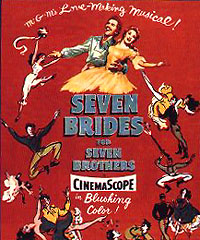|
We thought it was just another movie, something
to do on just another Saturday night. So
we bought popcorn, settled into our usual row, and
started to make out. Until the girls
pushed us away, more interested in other virgins
snatched from a town even smaller than
ours, trapped when an avalanche closed the pass
but safe and cozy in Milly's big ranch house
while the men slept in the barn and thought about
them in their layers of underwear.
After we dropped our girlfriends off that night
we met out past Bethel Church. Somebody
had some beer, and we leaned on the fenders
of our precious cars and talked about the girls
we'd been going steady with forever. In the movie when
the boys moon around and neglect their chores,
Jane Powell tells Howard Keel what's wrong. He can't
believe they're lovesick. "Why," he says, "they
ain't laid eyes on them girls but once." "Once," she
replies, "is all you need if she's the right one."
Were Sandy and Sonia, Mary and Faye the right ones,
we wondered. Was it a miracle we'd found
them in the vastness of the Mid-West? Or was there
another one -- the real one -- somewhere else?
So we saw the movie again. Sure the dancing was weird:
what was going on in the snow with that axe?
But Mark whispered that we should maybe buy color-
coded shirts like Adam, Benjamin, Caleb,
Daniel, Ephriam, Frank and Gideon. We could brawl,
and croon like the Pontipee brothers.
Then marry, have a slew of kids, and visit each other
on birthdays and holidays.
As our senior year ground on and Seagram's replaced
six packs, it was painfully clear we were
not like the seven brothers at all. We were never the ones
who fearlessly drove to Belleville or Granite City
to carry off from under the opposing team's very noses
someone we'd only longed for across a gymnasium.
We were already an audience, not much better than our
parents who sat on their front steps and stared.
Pretty soon, Mark broke up with Sandy. Mike and JJ started
to drink seriously and yell at their girlfriends.
Danny took Faye away from me and bragged about it. I filled
out college applications, then lost the tuition
at the race track,
Working graveyard, I had lots of time to think.
Instead, the movie played over and over in the dark part of
my mind. I began to identify not with the colorful
brothers, but with the young men who'd lost their girls to
the Pontipees. With no reason to stay, most of them
probably moved on. And although one or two were crestfallen,
certainly most remembered the incessant giggling
and prudishness and counted themselves lucky. I imagined
these men packing all they owned in two suitcases
and turning their backs on the brothers and their brides, all
pregnant by now, filling the aisles of the general
store as their husbands stood outside remembering what
it was like to dance on the planks at the barn
raising and to be full of a yearning that has not, even under
the circumstances, entirely disappeared.

Seven Brides for Seven Brothers was released by MGM as a CinemaScope movie "in blushing color" (see poster, left) in 1954. The storyline was adapted from US writer Stephen Vincent Benet's short story "The Sobbin' Women", set in the backwoods of Tennessee. The movie version, however, was set in the backwoods of Oregon, in the mid nineteenth century. Stephen Vincent Benet's short story was itself an adaptation of the ancient legend of the Rape of the Sabine Women, retold by Roman historians Plutarch, Livy, and others. The grim yet sentimental tale has been the subject of many paintings and sculptures over the two thousand years since it was first written down.
In a special supplement to this issue of Jacket, you can read some interesting background information about the movie, read Livy's version of the tale, and view two paintings based on the theme of the Sabine women - by the seventeenth-century French painter Nicholas Poussin, and Picasso. [editor's note]
Ron Koertge is a Professor of English at Pasadena City College in Pasadena, California. You can read five poems by Ron Koertge in the first issue of Jacket, and his homage to Frank O'Hara in Jacket # 10.
See the link to our bookstores page, below.
|
|

